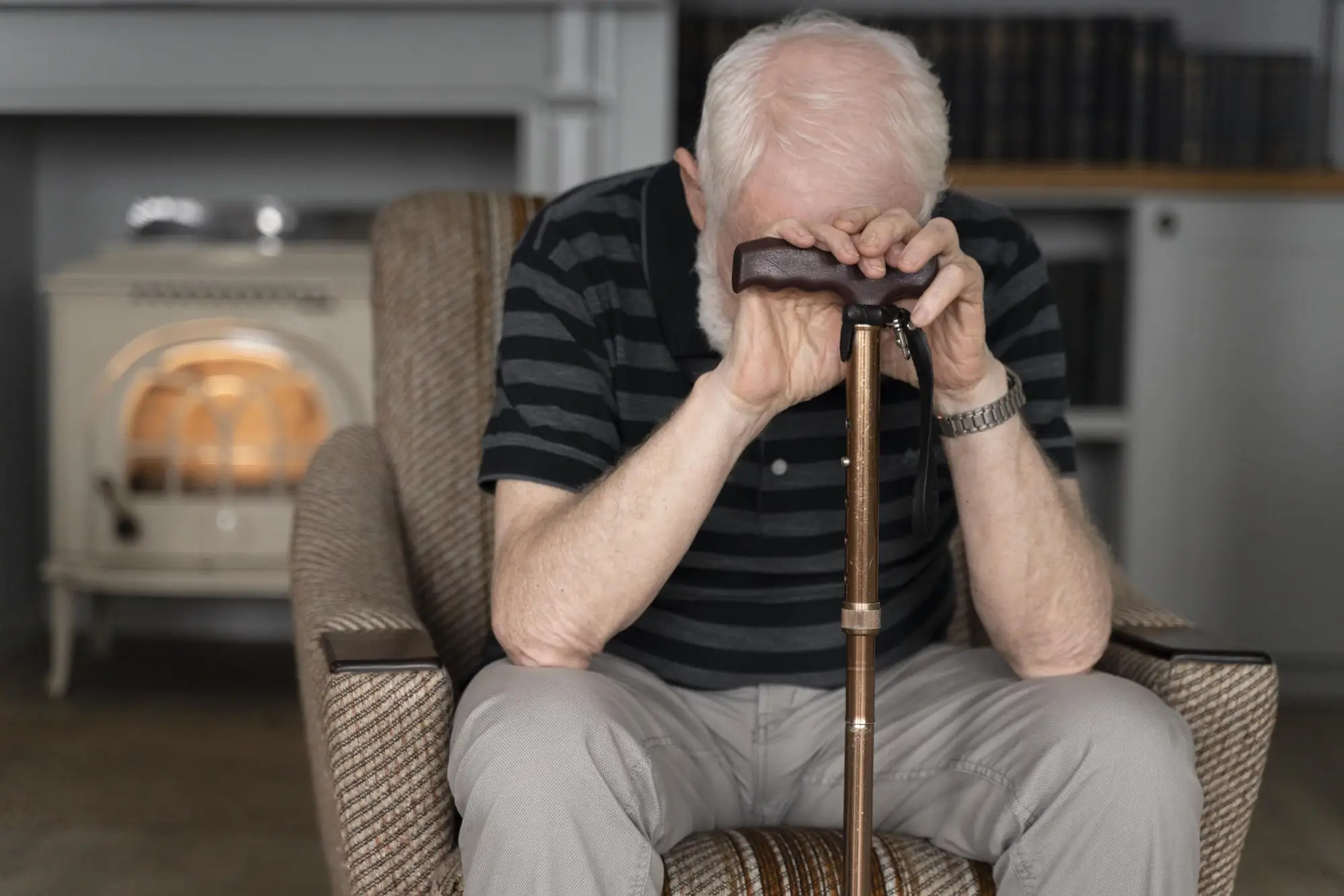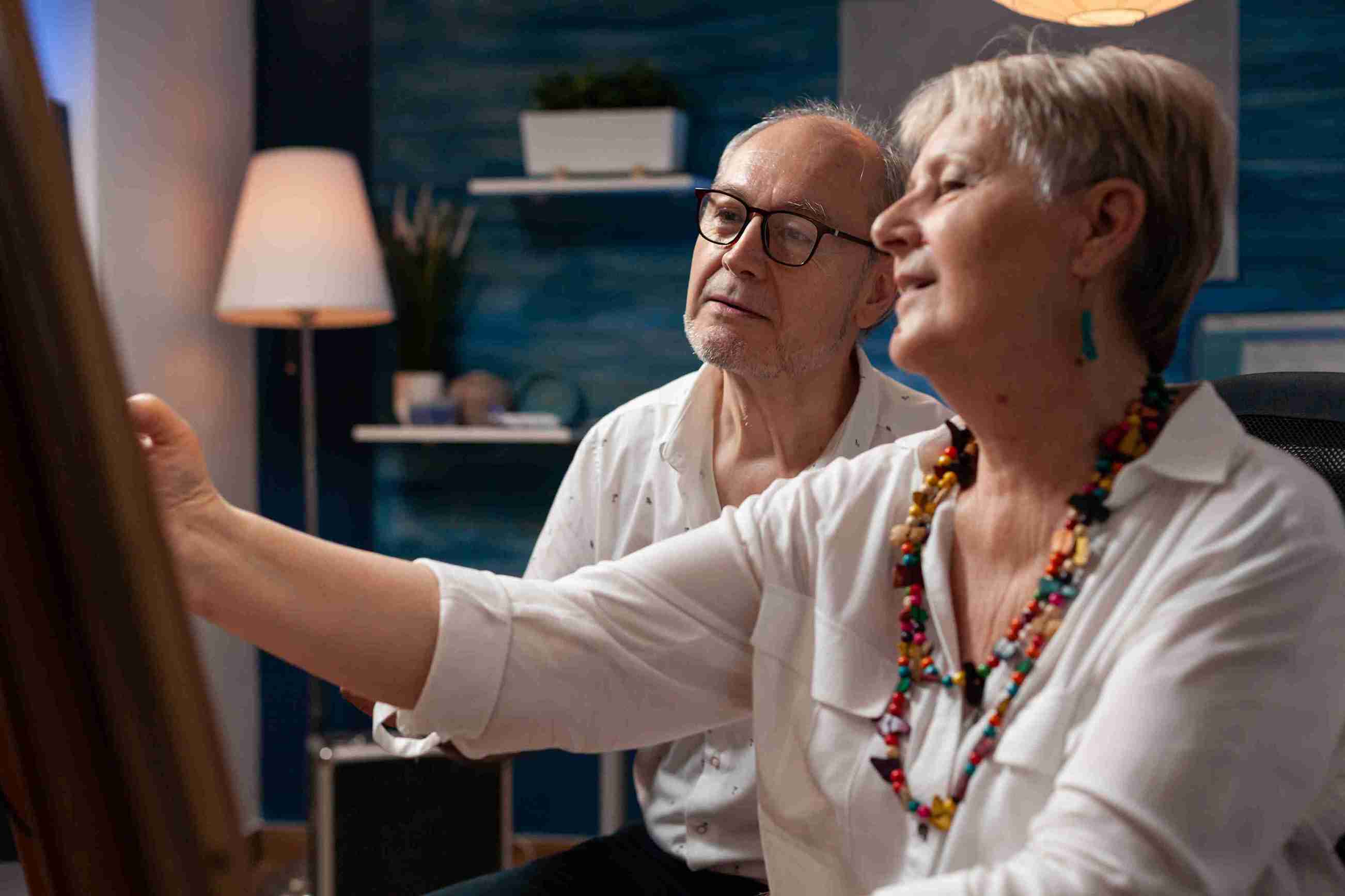When someone you love starts sleeping past noon every day, you might think they're just having a rough patch. When they push away their favorite meal for the third time this week, you figure their appetite will return soon. These small changes often signal that something bigger is happening. Learning to recognize symptoms 6 months before death gives families precious time to process emotions, arrange care, and create lasting connections before it's too late.
The Context of End-of-Life Signs
Bodies communicate through subtle changes long before dramatic symptoms appear. Skipping favorite activities. Choosing comfortable clothes over getting dressed up. Preferring quiet rooms to busy spaces. These aren't random quirks – they're early messages about what's happening inside.
End-of-life signs matter because they provide families with valuable time. Time to have important conversations. Time to arrange appropriate care. Time to focus on what truly matters while there's still an opportunity. Nobody wants to think about these possibilities, but recognizing them early prevents scrambling to catch up later.
These changes don't announce themselves clearly. They slip in gradually, disguised as normal aging or temporary setbacks. One week, someone needs a little longer to get ready. The next week, they're asking for help with tasks they've managed independently for decades. Medical professionals recognize these patterns regularly, but families experiencing them feel confused and frightened. Understanding what might be happening allows you to respond with intention rather than just worry.
6 Months Before Death Symptoms
Around six months before death, the body begins conserving energy differently. Someone who has always been an early riser suddenly needs to sleep until late morning. A person who loved elaborate cooking projects now finds making a sandwich feels overwhelming.
Energy becomes limited and precious. What happens 6 months before death often begins with people requiring significantly more sleep than usual. Not just feeling tired, actually needing 12 or 14 hours of rest to function at all. Their bodies redirect energy to maintain vital organs, similar to a phone switching to power-saving mode.
Food loses its appeal completely. Someone who never refused dessert suddenly has no interest in their favorite treats. A few months before the death, meals became difficult negotiations instead of shared pleasures. The body's metabolism changes significantly, requiring less fuel as all systems slow down.
Social activities feel exhausting now. Signs 6 months before death include someone who enjoyed large gatherings now leaving early or avoiding them entirely. This isn't about caring less for people – it's about having limited energy and choosing carefully where to spend it.
Families typically notice these changes:
- Morning routines are taking much longer than before
- Needing assistance with tasks they've done alone for years
- Clothes are becoming loose as weight drops steadily
- Declining invitations they would have accepted eagerly before
- Preferring a television volume lower or turned off completely
- Ending phone conversations more quickly than usual
Understanding these patterns helps families work with natural changes instead of fighting against them.
Individual Timing Varies
The six-month timeframe isn't set in stone. Some people show these signs much earlier, others display them later. What matters most is recognizing the overall direction rather than focusing on exact timing. A few months before death, symptoms might appear suddenly after a hospital stay or develop gradually over many weeks. Look for clusters of changes rather than single incidents. One symptom alone might not mean much. Several together create a clearer picture.
Common Physical Symptoms
Physical changes during this period often surprise families with how quickly they progress once they begin.

Energy and Mobility
Exhaustion feels different now. This isn't the tired feeling after a busy day – it's deep fatigue that rest doesn't improve. Walking to the bathroom becomes genuinely difficult. Taking a shower requires planning and recovery time afterward.
Balance becomes unreliable quickly. Someone who never needed support suddenly grips handrails tightly on stairs. Falls become a serious concern as reflexes slow and coordination weakens. Many families resist mobility aids until something frightening happens, but accepting help early prevents dangerous situations.
Simple movements require much more effort than before. Standing up from a chair might take several attempts. Getting in and out of cars becomes awkward and slow. These changes reflect a genuine decline in the body's strength and coordination.
Breathing and Circulation
Shortness of breath appears during activities that never caused problems previously. Climbing stairs requires rest stops partway up. Walking from the car to a store entrance leaves them breathless and needing to sit down.
Circulation slows in ways you can observe. Hands and feet feel cold even when the house is warm. Skin color might appear paler than normal or take on a grayish tone. Blood pressure readings become more erratic than they used to be.
Heart rhythms can become irregular. Sometimes racing, sometimes very slow. The cardiovascular system struggles to maintain steady performance as everything in the body works harder just to continue functioning.
Physical Appearance
Weight decreases regardless of family efforts to encourage eating. Clothes that fit properly last month now hang loosely. Facial features become more prominent as the body loses fat deposits. This weight loss often concerns families more than it bothers the person experiencing it, who may feel relieved by decreased appetite.
Skin changes tell their own story. Small cuts or bruises heal very slowly, taking weeks instead of days. 2 weeks before death, skin might appear mottled or develop a waxy quality as circulation continues declining.
Temperature control becomes inconsistent. They might need blankets when everyone else feels comfortable, or suddenly feel overheated in normal temperatures. Their body's internal thermostat loses its accuracy as systems slow down.
Emotional and Psychological Shifts
Emotional changes during this time can feel unpredictable and intense. Feelings swing unexpectedly, and reactions that seem unlike their normal personality often emerge.
Mood and Behavior Changes
Fear appears in unexpected ways. Someone who has never been anxious might suddenly worry about many things, like home security, weather, or what will happen to beloved pets. Others become unusually calm, almost peaceful. Both responses represent normal ways of processing the reality that life is ending.
Anticipatory grieving affects the dying person as much as their families. They mourn missing future events – grandchildren's graduations, next spring's garden, or never knowing how their favorite story ends. This grieving before death serves an important function. It's emotional preparation, though painful to witness.
Memory becomes selective in interesting ways. They might recall detailed childhood stories while forgetting recent conversations. This isn't necessarily a disease process, it's the brain focusing on what feels most meaningful while releasing details that seem less important.
Spiritual Questions
Questions about meaning and purpose intensify, regardless of previous religious beliefs. Someone who never discussed faith might ask about afterlife concepts. Others revisit childhood religious teachings or express concerns about forgiveness for past actions.
Life review becomes consuming. They want to share stories, especially about relationships and experiences that shaped their identity. These conversations preserve their legacy while processing what their life has meant.
Anticipatory bereavement begins affecting family members as they watch the decline accelerate. Learning how to deal with grief before death means accepting that sadness is appropriate, seeking support when needed, and making space for both grief and moments of joy during the remaining time.
Acceptance and Resistance
Some days bring surprising acceptance and peace. Others bring anger, deep sadness, or fear. Both happen naturally, sometimes within the same day. Good days might include laughter, storytelling, and feeling connected. Difficult days bring tears, withdrawal, or irritability. All these emotions are normal parts of processing something as significant as dying.
Don't expect steady progress toward acceptance. Emotions change unpredictably. Someone might seem at peace in the morning and feel angry by afternoon. This emotional variation is part of working through feelings about life ending.
Social and Interpersonal Changes

6 months before death
Relationships change significantly during this time. Social energy becomes limited and valuable, used carefully for the most important connections.
Communication Patterns
Conversations change in both content and style. Long discussions feel exhausting, but brief exchanges can carry enormous emotional weight. Many people prefer listening to talking, finding comfort in familiar voices without pressure to maintain their part of the conversation.
Phone calls become shorter but sometimes more meaningful. 3 months before death, many people express clear preferences about who they want to see and when. Close family members might receive most of their limited social energy, while other relationships take less priority. They might stop responding to calls or messages, not because they don't care, but because responding feels overwhelming.
Relationship Priorities
Visitor preferences become highly selective. They might welcome certain people while finding others completely draining. This isn't about favoritism. They try to preserve energy for relationships that provide the most comfort and meaning.
Old conflicts suddenly feel urgent. Arguments that continued for years might need resolution now, or they might choose to release grievances entirely rather than spend precious energy on past hurts. Some people use their remaining strength to repair damaged relationships. Others decide that forgiveness matters more than being right.
Family roles shift in uncomfortable ways. Adult children might need to make decisions for parents who have always been in control. Spouses take on responsibilities their partners handled for decades. These changes require patience and understanding from everyone involved.
Legacy Preservation
Sharing family stories becomes a priority. They might want to record messages for future celebrations, distribute meaningful possessions, or write letters to be opened later. This legacy creation helps them feel their influence will continue beyond their death. Photo albums appear frequently. They want to remember, and they want others to remember with them. These storytelling sessions serve important functions – preserving family history while processing the significance of relationships and experiences.
Recognizing Pain and Discomfort
Pain becomes complicated during end-of-life because physical discomfort intertwines with emotional and spiritual suffering in ways that make everything more difficult to address.
Physical Pain Indicators
Pain manifests differently as the body weakens. Discomfort that used to be manageable can become overwhelming quickly. Positioning becomes critical – small adjustments to pillows or bed height often provide significant relief when medication alone isn't sufficient. When someone cannot communicate clearly, careful observation becomes necessary. Watch for:
- Facial tension or grimacing
- Restlessness or constantly changing position
- Changes in breathing patterns (faster, slower, or irregular)
- Moaning or other sounds of discomfort
- Pulling away when touched or moved
- Increased confusion or agitation
These non-verbal signs often communicate pain more clearly than words, especially when someone is too weak or confused to explain what hurts.
Emotional and Spiritual Suffering
Emotional pain often intensifies physical discomfort. Sadness about leaving loved ones, fear about the dying process, or guilt about past mistakes can amplify every ache and pain. Sometimes addressing emotional needs provides surprising relief from physical symptoms. Spiritual distress appears as questions about meaning, purpose, or what happens after death. Worry about forgiveness, regret about missed opportunities, or fear of being forgotten can create profound suffering that pain medication cannot address.
The Role of Hospice and Palliative Care

Hospice care fundamentally changes the approach during the final months. Instead of focusing on fighting disease, the entire goal shifts to maximizing comfort and meaning for whatever time remains.
Understanding Hospice Services
Hospice begins when doctors estimate life expectancy at six months or less. This isn't about giving up hope – it's about changing goals from cure to comfort. Teams include doctors, nurses, social workers, chaplains, and volunteers who work together addressing all aspects of end-of-life needs.
The approach differs significantly from traditional medicine. Instead of ordering more tests or trying new treatments, hospice focuses on pain management, symptom relief, and emotional support. Medications get adjusted for comfort rather than cure, often providing better pain relief than previous approaches.
Equipment comes to the home – hospital beds, oxygen, wheelchairs, whatever makes daily life easier and more comfortable. The goal is to transform homes into peaceful, supportive environments where families can focus on connection rather than medical management.
Family Support Services
Support extends beyond patient care to include family education and emotional assistance. Hospice teams teach families what to expect, how to cope with caregiver stress, and healthy ways to begin processing grief. They provide respite care when families need breaks, and emotional support when everything feels overwhelming. This help continues after death through bereavement services. Many families find these ongoing connections valuable during the most difficult months following their loss. Grief doesn't end when life does, and hospice recognizes this reality.
Coordinating Care Decisions
Hospice teams excel at helping families navigate difficult conversations about prognosis, treatment options, and end-of-life wishes. They create safe spaces for expressing fears and concerns that families often struggle to discuss independently. They also coordinate practical matters like funeral services, connecting families with resources, and helping plan ahead when thinking clearly is still possible.
The Role of Healthcare Professionals
Healthcare teams become essential support systems during end-of-life transitions. Their expertise extends beyond medical knowledge to include emotional support and practical guidance when families feel completely overwhelmed.
Medical Team Coordination
Doctors who specialize in end-of-life care have unique skills in symptom management and family communication. They translate complex medical information into language families can understand, helping everyone make informed decisions about care options.
Nurses provide hands-on care while teaching family members basic comfort measures. They demonstrate positioning techniques, explain medication administration, and identify signs requiring immediate attention. Their regular presence creates security for both patients and families.
Support Specialists
Social workers address practical concerns that medical professionals cannot handle. They connect families with financial resources, help navigate insurance complications, and coordinate community services that might provide assistance. Chaplains offer spiritual care regardless of religious backgrounds. They listen to concerns about meaning, purpose, and afterlife questions. Their presence provides comfort even for families who haven't considered spiritual support important previously.
Specialized Knowledge
Different medical conditions create unique end-of-life challenges requiring specific understanding. For families dealing with stroke-related decline, recognizing signs of impending death after stroke provides valuable preparation for condition-specific changes that might occur. Cancer, heart failure, dementia, and other conditions each have their own patterns and timelines. Healthcare professionals help families understand what to expect based on specific diagnoses rather than general end-of-life information.
When to Seek Support and What to Do Next
Recognizing when professional support becomes necessary saves families from prolonged struggles with overwhelming caregiving responsibilities. Early intervention provides more options and better outcomes for everyone involved.
Warning signs that indicate the need for additional support include:
- Caregiver exhaustion reaching dangerous levels where family members cannot function effectively. Sleep deprivation, increased illness among family members, or emotional breakdowns signal an urgent need for help.
- Symptom management exceeding family capabilities. Uncontrolled pain, breathing difficulties, or other physical changes requiring medical expertise warrant professional intervention.
- Family conflict about care decisions creating additional stress. When disagreements about treatment approaches or care settings divide families, professional mediation helps resolve disputes.
- Patient expressions of readiness for different care approaches. Someone saying they're "tired of fighting" or asking about comfort care options may be ready to consider hospice services.
- Practical concerns overwhelming family resources. Financial strain, employment conflicts, or housing issues require professional assistance to resolve.
Taking action involves several steps:
- Contact primary care physicians to discuss changing needs and available options. Many doctors initiate these conversations, but families should feel comfortable bringing up concerns.
- Research local hospice and palliative care providers. Most organizations offer free consultations to determine the appropriateness of services.
- Consider family meetings, including all involved relatives. These discussions allow everyone to express concerns and participate in decision-making.
- Explore emotional support resources, including counseling, support groups, and spiritual care. Many communities offer specific programs for families facing end-of-life situations.
- Document important information including medication lists, emergency contacts, and care preferences. This preparation reduces stress during crisis situations.
The path through end-of-life changes challenges everyone involved, but understanding what lies ahead provides strength for the journey. Recognizing signs early allows families to focus on love, connection, and comfort rather than fighting impossible battles. With proper support and preparation, these final months can become times of profound meaning despite their inherent sadness.
Through accepting professional help, maintaining open communication, and prioritizing comfort over cure, families create environments where people can pass away with dignity, surrounded by love. This represents the greatest gift we can offer those approaching life's end – the assurance that they will not face this transition alone.
FAQ
What are the common symptoms 6 months before death?
In six months before death, patients show a number of physical and mental changes. Some of the most common changes include progressive fatigue, loss of appetite, emaciation, and social withdrawal. Also, some patients lose some memory and other cognitive changes. Identification of these symptoms in its early stages puts the appropriate intervention of hospice at the right time to control discomfort and maximize quality of life at the most desired and needed time.
What are the pre-death signs that tell a person is transitioning to death?
Physical pre-death signs of a person transitioning to death from the pre-palliative stage include a massive decline in physical abilities, such as difficulty maintaining the swallowing of food, decreased mobility, and poor respiration. Other signs may be observed, such as confusion, restlessness, and altered consciousness. These signs usually mean that the body is preparing for the last stages of life and indicate bed preparation for comfort and provision of appropriate care.
What symptoms do you have 6 months before death?
months before death, individuals may experience symptoms such as increased fatigue, decreased appetite, weight loss, changes in breathing patterns, and withdrawal from social activities. These signs often indicate the body's gradual decline and should be monitored closely. Consulting a healthcare provider can help manage these symptoms and provide the necessary care during this time
What happens before death in the last weeks and days?
Common symptoms experienced by patients in the last weeks and days of life are labored breathing, a farthest decline in responsiveness, and a fall in blood pressure. Skin condition changes cool to touch, discoloration; and may also stop eating and drinking. During this time, hospice care effectively focuses on comfort, pain management, and attending to the emotional needs of both the patient and their family members.
What are the signs of end-of-life that caregivers should be aware of?
Signs of end of life care may include a noticeable decline in appetite, leaving much more food uneaten than previously, particularly increased sleep, and a change in breathing patterns. Other things to look out for include a gradual, steady decline in body temperature, a decrease in urinary output, and decreased communication from the patient. End-of-life signs would guide caregivers in determining what interventions suit the patient and provide comfort.
What are the elderly signs of dying that show your loved one is at the end of life?
Some elderly signs of dying include becoming very weak, difficulty swallowing, increased sleep, lack of interest in eating or drinking, confusion, disorientation, and decreased urine output. These are mostly symptoms of a person approaching the end of life, so critical care and support must be rendered to the individual during such stages.
















.webp)




.webp)

.webp)

